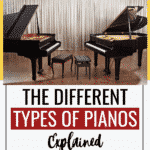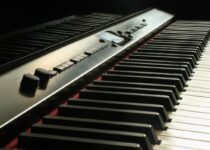It would be fair to say that the piano is the most popular musical instrument of all time. It is capable of producing beautiful music, it’s incredibly versatile, and the keyboard layout makes it perfect for learning musical concepts.
There are several different types of pianos out there, broken down into three main categories: horizontal (or grand), vertical (or upright), and electric (or digital). The three main categories can interchange to combine other sub-styles.
Here’s a rundown of the different types of pianos:
- Vertical Pianos (uprights)
- Spinet
- Console Piano
- Studio Piano
- Full Size Upright
- Player Piano
- Horizontal Pianos (grand pianos)
- Petite Grand
- Baby Grand
- Parlor Grand
- Ballroom Grand
- Concert Grand
- Digital Pianos
- Digital Console Piano
- Portable Stage Piano
- Arranger Piano
In this article, we take a look at the modern piano and the many different types that are produced today.
Post Contents
History of the Piano
Before we look at the types of pianos available today, let’s briefly go through the history of the piano.
Early pianos
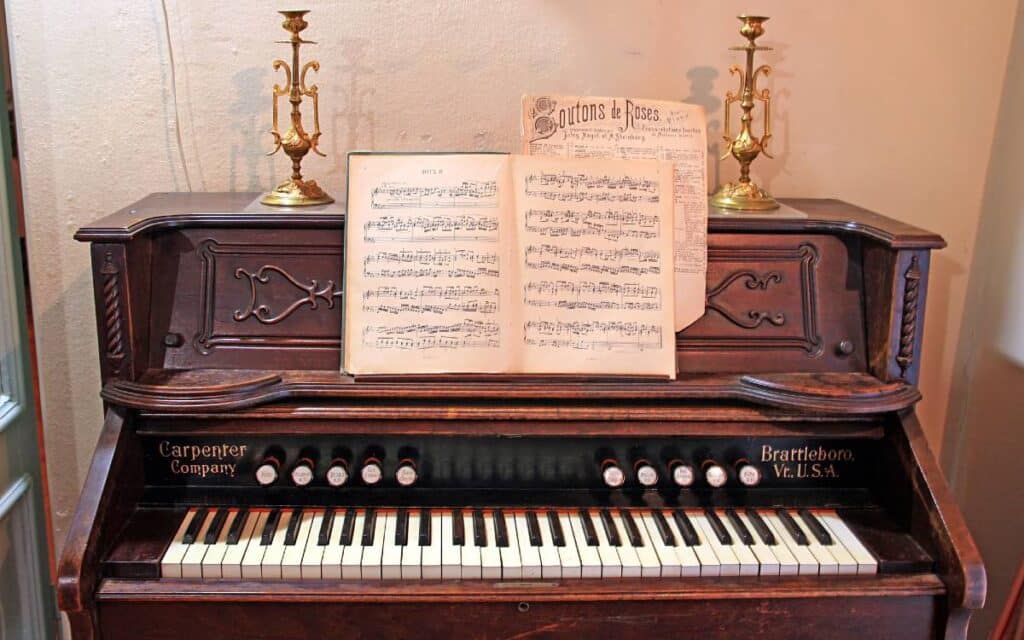
Before the piano came the harpsichord. It still had keys and strings, but rather than a hammer striking the strings, they were plucked with a mechanism called a jack.
The harpsichord was a very popular instrument, but it produced a very limiting sound.
At the turn of the 18th century, a man called Bartolomeo Cristofori invented the hammer mechanism and what we now think of as first type of piano. The main difference from the modern piano, is the original piano forte had 49 keys rather than 88.
Aside from the number of keys, pianos have changed very little. The traditional acoustic piano that we all know and love today is almost identical to the first pianos that Steinway built back in the early 1800s.
The Different Piano Types
So now that we know a little about the history of the piano, let’s take a more detailed look at the range and types of pianos available today.
Horizontal Pianos
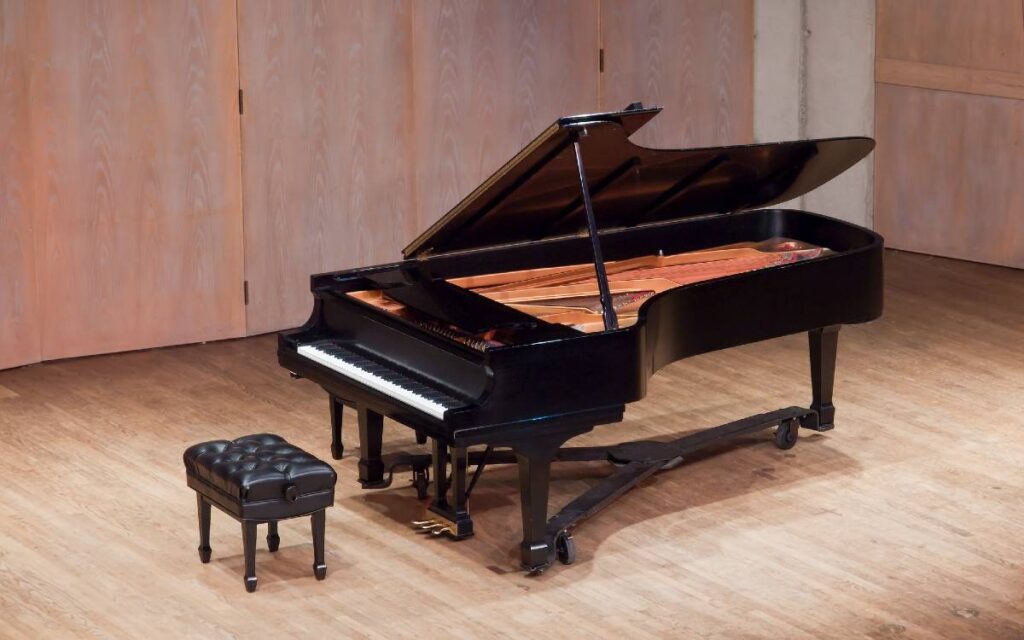
This category of piano uses the term horizontal because the piano strings run parallel to the floor.
The more common term for horizontal pianos is grand pianos. Grand pianos can range in size from 5ft to 9ft and can produce a sound that is more powerful than that of a vertical piano.
They produce a richer sound quality because the strings are longer and the soundboard area is larger than upright pianos. There’s no doubt that grand pianos have a rich tone to their sound, which is why they work so well in concert halls.
Types of Grand Pianos
Grand pianos fall into five main classifications. Petite grand, baby grand, parlor grand, semi-concert grand, and concert grand pianos.
Along with their different sizes, each grand piano has its different uses and set of pros and cons.
Petite Grand
As the name suggests, the petite grand piano is the smallest of all the grand pianos. The width and number of keys are the same as its larger cousins. However the length is noticeably smaller, coming in at just 55 – 58 inches. Compare that to a concert grand which is up to 108 inches long, the petite grand is almost half its size.
The petite’s size is its downfall. It does not produce the same quality of sound as the larger models. The reduction in sound quality is due to it having a smaller soundboard, so its no surprise that the sound is poorer.
These pianos may be petite but they are still incredibly heavy, weighing in excess of 400 pounds. You won’t be moving one of these pianos on your own!
Baby grand piano
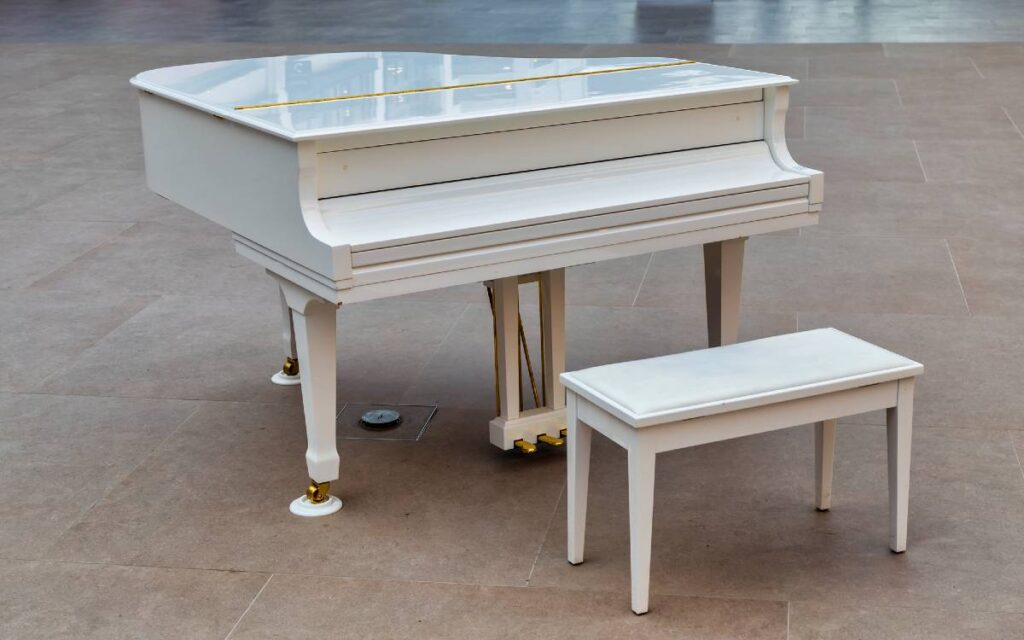
Baby grand pianos are the type of grand piano that you will be most familiar with, even if you don’t realize it. You will often see cute little baby grand pianos in hotel lobbies or piano bars.
Most baby grands will fit in smaller spaces while producing clarity of sound usually reserved for concert grand pianos. Professional musicians can really make a baby grand piano sing out.
In terms of size, a baby grand piano is between 65 to 75 inches long and weighs around 550 pounds.
Medium grand piano
The medium grand piano also goes by the names of living room grand and parlor grand. The parlor grand piano is the type of grand piano found in the living room of expensive houses.
Small music venues and rehearsal rooms are also likely to use this type of grand piano. Some beginner pianists may also be lucky enough to learn on a medium grand.
Medium grand pianos are not much bigger than a baby grand at 69 – 79 inches long but weighs a hefty 750 pounds.
Ballroom or semi-concert grand piano
Guess why this grand piano is called a ballroom? Yep, you guessed right, it’s most commonly found in ballrooms, music halls, and performing arts venues.
The tone quality is similar to that of a concert grand minus the huge size which makes it a good choice for ballrooms etc. You are also likely to find these types of pianos in a recording studio.
It measures 78 – 89 inches long and weighs in at a whopping 900 pounds.
Concert grand piano
The concert grand piano is the daddy of a baby grand. It has longer strings and a huge soundboard and the two combine to create a very powerful sound.
If you’ve ever attended a performance by a symphony orchestra, you will have seen and heard a concert grand in action. Piano concertos are played on concert grands and larger recording studios may also use one.
This video demonstrates the beautiful sounds achieved when playing a concert grand.
Concert halls over the world will have a concert grand piano though they don’t come cheap. Brand new concert grands cost upwards of $120,500.
Upright pianos
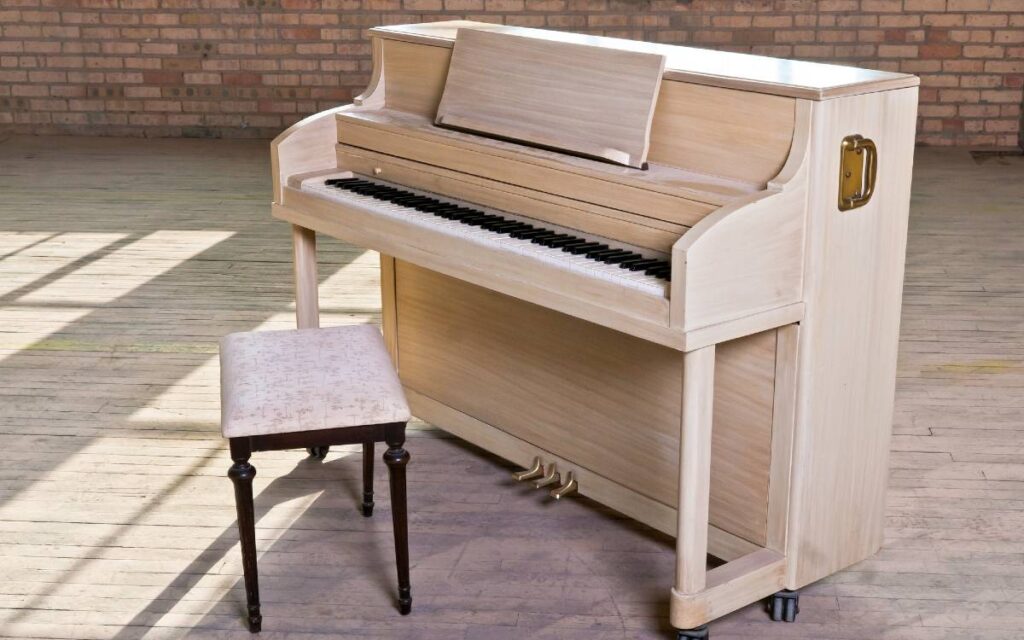
Upright pianos are also called vertical pianos. Uprights are the most common types of pianos and the one most likely to be found in homes around the world.
Years ago, before the invention of the radio and TV, pianos provided family entertainment. You may remember bashing away on your grandma’s piano.
Upright pianos work in the same way as a horizontal piano. They contain strings, use hammers to strike the keys, and have a soundboard, except they have one major difference. Everything runs upright.
The major benefit to this design of piano, is it can fit into far smaller spaces than a grand piano, which is why this is the most popular piano. Piano lessons are more often taken on an upright piano.
Like the grand piano, there is more than one type of upright piano and they each have their own unique features.
Spinet
A spinet piano was the smallest of all upright pianos. We say was because spinet pianos are no longer manufactured.
The small size of the spinet piano meant that the method of the hammer striking the strings was not possible. Instead, it used a mechanism called ‘drop action’, which quite literally meant the hammers dropped onto the strings. You can see an example of a drop action piano in this video.
The inside of a spinet was so cramped that they were difficult to repair or tune and they eventually fell out of favor. Despite the fact that they are no longer made, they are still available to buy second-hand.
Console piano
Console pianos are the next size up from a spinet piano. They range in size from 40 to 44 inches in height and are a popular choice of upright piano.
Although console pianos are still a smaller pianos, they have longer piano keys than a spinet, which connect directly to the hammer. The pianist will feel more control over the keys and produce a more dynamic sound.
Player piano
A player piano or pianola, is a self-playing upright piano that was popular in the 1920s. It was a piano that played itself.
It was made for homes so that people could listen to their favorite piano music of the time. A roll of sheet music with holes punched into is was inserted into the piano. Once activated, a pneumatic mechanism would operate the piano keys.
It fell out of popularity once phonograph recordings and the radio became more wildly available.
Modern player pianos are available, though they use digital sounds and programming. Some original player pianos are still in existence, though they are quite rare. Here’s an example of one that was renovated and you can see that it was a pretty cool invention.
Studio piano
The studio piano is sturdy upright piano that is commonly found in schools, churches and studio environments. They sit at around 45 to 47 inches tall and were designed so that the pianist could see the conductor over the top of the piano.
Studio pianos are a big leap from a console piano and contain full action hammer keys. The increase in action enables the player to have better control over the piano keys. More controlled actions means better expression and tone quality.
Studio pianos are usually used for teaching in piano lessons.
Studio pianos are the smallest of the upright pianos to contain full size piano hammers and full legnth vertical strings.
Often the keys are longer than the keys of the console piano and this again aids control and musical expression.
Full size upright piano
As the name implies, these upright pianos are the largest of all the vertical pianos. The soundboards are almost the same size as a baby grand piano.
If you don’t have the space for a baby grand piano but want the same sound, this piano makes for a perfect alternative.
You will often see these types of pianos referred to as professional uprights. They can be as expensive as a grand piano, but if you are a serious or professional player with little space for a grand piano, this is a good alternative.
Electric Pianos and Digital Pianos
Now that we’ve looked at all the available traditional pianos, lets turn our attention to the digital realm.
It’s easy to think of these as the same type of piano. But despite the crossovers between the two there are significant differences.
Electric piano
This piano gained popularity back in the 1950s, after it was used by musicians like Duke Ellington and Ray Charles.
This type of piano produces a sound when the key is struck and the hammer strikes a metal string or reed. This causes vibrations to convert into electrical signals connected to an amplifier.
Modern digital pianos can emulate the electric sound of this piano, although some performers still prefer the sound of a genuine vintage instrument.
Synthesizer
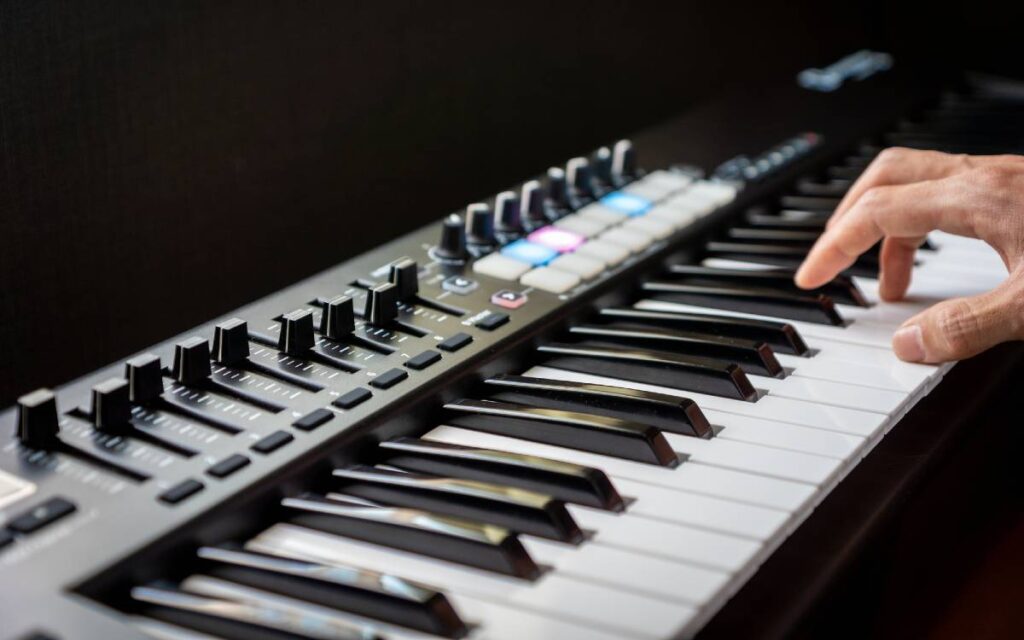
A synthesizer or synth is a an electronic musical instrument that looks like a keyboard. They generate tones via an oscillator, rather than amplifying the sound of metal strings.
Musicians first viewed synthesizers with some cynicism, but after they were adopted by electronic acts in the 1960s the value of the synthesizer became apparent.
The popularity of the synthesizer keyboard took off in the 1980s and today it is used in almost every genre of popular music.
Electronic Piano
The electronic piano works along the same lines as a synthesizer, generating tones via an oscillator. They are built to mimic the sound of acoustic pianos.
The first electronic pianos where made in Italy in the 1970s and were adopted by musicians of the time including Genesis, Elton John and Yes.
The early electronic pianos could not vary their volume depending on how soft or hard the keys were played.
The electronic pianos popularity was affected in the 1980s when digital pianos and synthesizers became more affordable and able to replicate the sound of the electronic piano.
Digital Piano

Digital pianos more closely replicate the feel, sound of look of a traditional piano. They typically have weighted or hammer action keys, and sound samples of different instruments, including grands and baby grands. Digital pianos are a good choice if you are learning to play the piano and don’t have budget for an acoustic upright piano.
Digital pianos can replicate the sounds of electric pianos, organs, harpsichords, Hammond organs, and even string and wind instruments. They are a popular instrument choice for music studios and music schools due their wide range, affordability and ease of transportation
Digital console pianos look like an acoustic piano, have a damper pedal and a realistic looking keyboard. These types of digital pianos may even have wooden keys that give the player the same feel as playing real pianos. Higher end models, like the Yamaha Arius, will have more enhanced tone qualities and keyboard action.
There are also digital grand pianos available, although they are much less common and much more expensive.
Stage Piano
Stage pianos are made for portability and performing on stage in a band setting. Manufacturers like Korg, Roland, and Nord produce some topnotch stage pianos for performers.
Some stage pianos are hybrids, featuring real piano hammer action along with high quality samples of acoustic pianos. In this way, they mimic the sound and feel of an actual piano, while affording for portability and amplification.
Toy Pianos
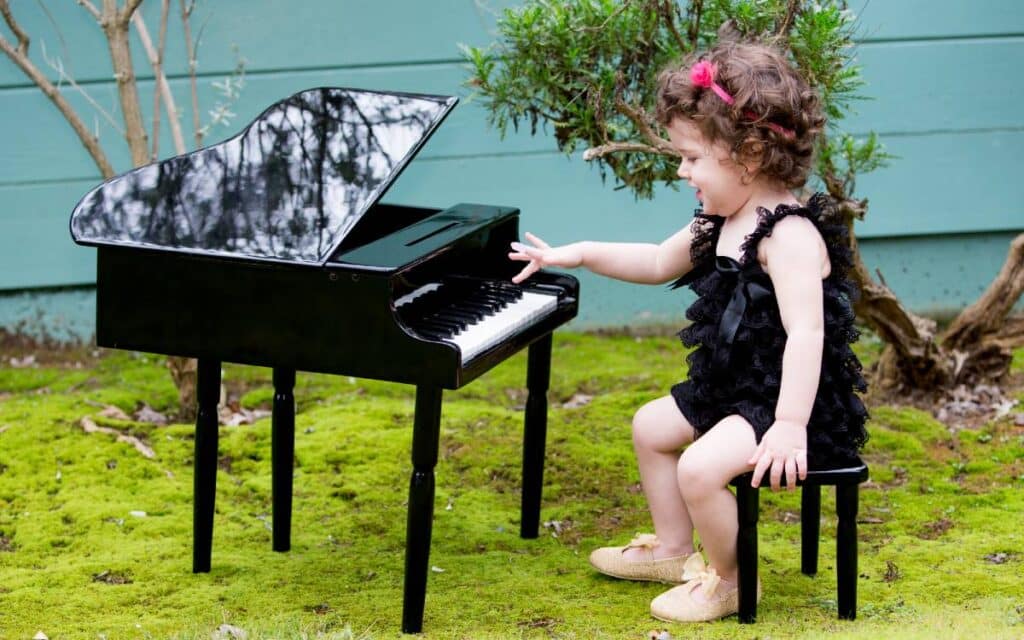
Toy pianos can be a great introduction to music. You can start you child off with a basic piano mat which produces a sound when the child steps on or presses the pads.
Toy pianos have limited keys and are designed for your toddler to have fun with them. They are certainly not designed to make any professional sounding music. However, a toy piano can give you some indication that your child is serious about learning to play piano.
Some toy pianos have color coded keys and a accompanying book. The child identifies the keys from the colors and learns to play a basic tune.
How to choose a piano?
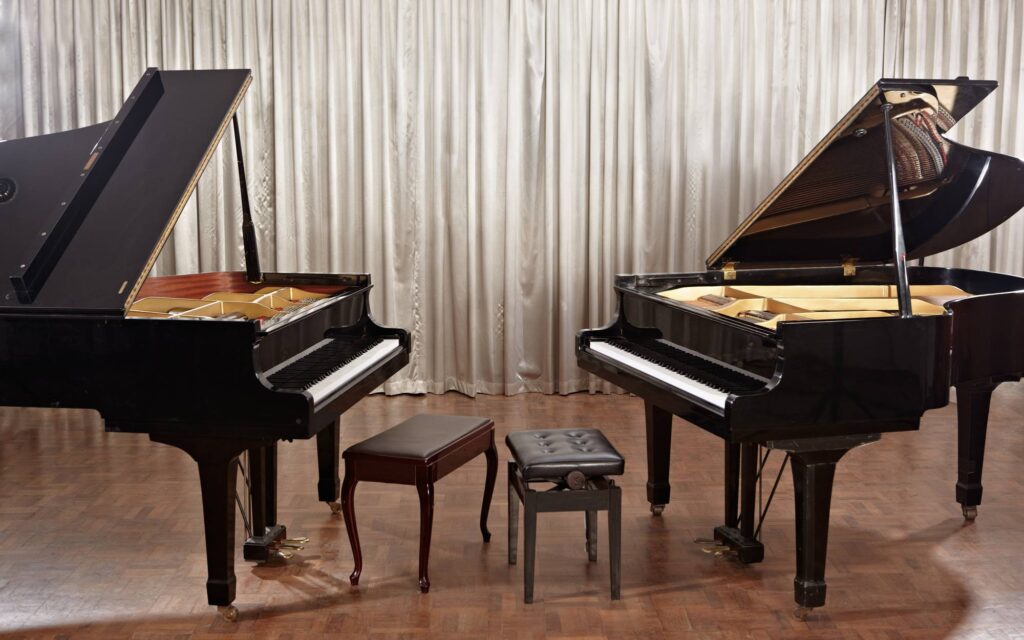
When it comes to choosing the correct piano for you, where do you begin? With so many types of pianos available it can be hard to make the right choice.
Play the piano
We recommend that when buying your first piano you don’t just pick one on online and decide that’s the one.
Go to a music store and play different pianos. Even if you choose to buy online afterwards, at least get a feel for different acoustic pianos and digital piano.
Turn up the volume
Assuming you want to buy a digital piano, ask the store for some headphones. That way you can play the piano as loud (and as badly) as you want without disturbing anyone.
Budget
Of course your budget will come into play when choosing a piano, but we recommend that you don’t just go for the cheapest. If you find a piano that you love, shop around for deals or maybe buy one second hand.
Keyboard width
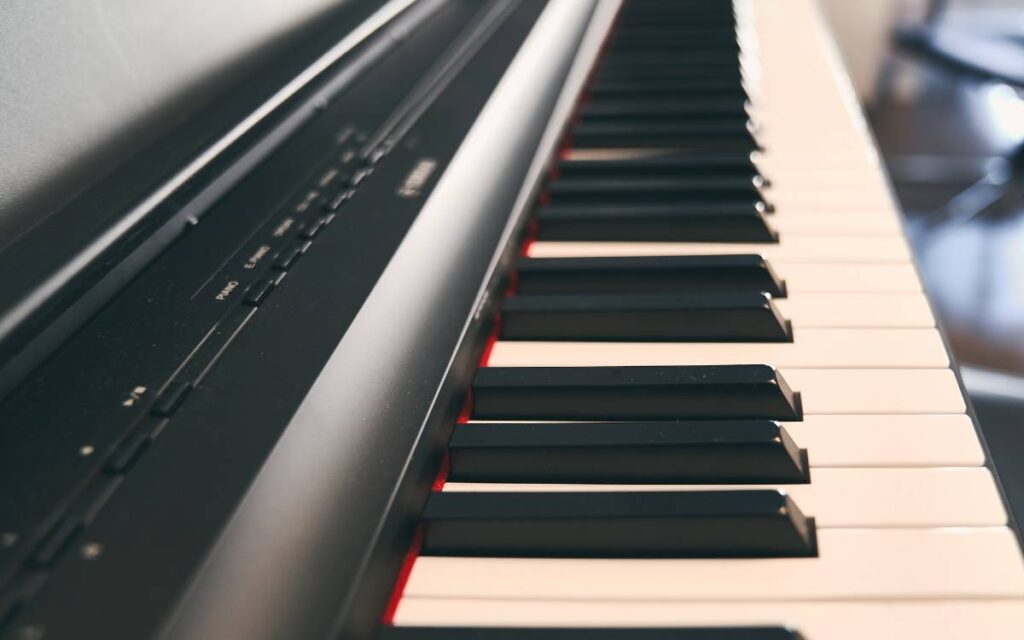
Most pianos have a standard keyboard with 88 keys, but not all digital pianos have the full range of keys. There’s nothing wrong with that, after all you don’t always use all 88 keys.
However, you want a keyboard that has at least 61 keys that respond to your touch. Meaning they will play loud or quiet depending on how hard you press the key.
Weird and unusual pianos
So, we’ve looked at whole range of pianos, but what about the more unusual types of pianos that are not widely available?
Victorian Piano Bed
The Victorians loved a piano, but what if you had guests staying for the night? Most Victorian homes were too small for a piano and a bed.
Thanks goodness then for the piano bed. After you finished playing the piano, simply convert it into a bed. Now you’ve got a music room and guest room in one!
Square Grand Piano
In the 18th century, piano makers built small rectangular Pianos. The piano strings ran from left to right rather than front to back which made the pianos much smaller than a traditional grand.
The size of these square pianos made them very popular with European households and although they are no longer popular today, they were the piano of choice for more than 150 years.
Piano for the Bedridden
What can you do if you love to play the piano but you are confined to bed?
Back in 1935 when tuberculosis was rife and people were confined to bed, innovative manufacturers created a piano that had keyboard that could extend over the bed. Genius!

